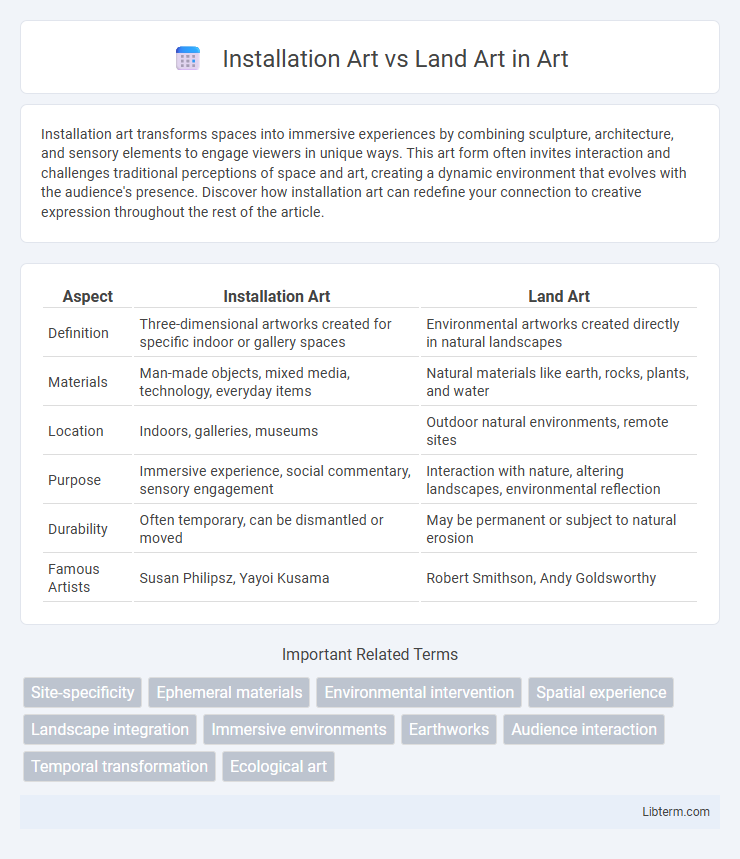Installation art transforms spaces into immersive experiences by combining sculpture, architecture, and sensory elements to engage viewers in unique ways. This art form often invites interaction and challenges traditional perceptions of space and art, creating a dynamic environment that evolves with the audience's presence. Discover how installation art can redefine your connection to creative expression throughout the rest of the article.
Table of Comparison
| Aspect | Installation Art | Land Art |
|---|---|---|
| Definition | Three-dimensional artworks created for specific indoor or gallery spaces | Environmental artworks created directly in natural landscapes |
| Materials | Man-made objects, mixed media, technology, everyday items | Natural materials like earth, rocks, plants, and water |
| Location | Indoors, galleries, museums | Outdoor natural environments, remote sites |
| Purpose | Immersive experience, social commentary, sensory engagement | Interaction with nature, altering landscapes, environmental reflection |
| Durability | Often temporary, can be dismantled or moved | May be permanent or subject to natural erosion |
| Famous Artists | Susan Philipsz, Yayoi Kusama | Robert Smithson, Andy Goldsworthy |
Introduction to Installation Art and Land Art
Installation Art transforms spaces by incorporating diverse materials and sensory experiences to immerse viewers, often in galleries or urban settings. Land Art, also known as Earth Art, utilizes natural landscapes as both medium and canvas, creating large-scale outdoor sculptures that interact with the environment. Both forms challenge traditional art boundaries by emphasizing spatial context and viewer engagement.
Historical Origins and Development
Installation Art emerged in the 1960s as an immersive, site-specific practice rooted in modernist traditions and influenced by Dada and Surrealism, emphasizing viewer interaction and sensory experience. Land Art originated simultaneously in the late 1960s and early 1970s, primarily in the American Southwest, driven by artists like Robert Smithson and Michael Heizer who used natural landscapes to challenge traditional gallery spaces and critique environmental and cultural issues. Both movements reflect a shift from object-based art to experiential environments but differ in context; Installation Art often occupies urban or indoor settings, while Land Art integrates directly with natural terrain.
Key Characteristics of Installation Art
Installation art transforms spaces through immersive, multi-sensory environments that engage viewers physically and emotionally. It often incorporates a variety of materials, including found objects, technology, and light, to create site-specific experiences that challenge traditional notions of art. Unlike land art, which emphasizes natural landscapes, installation art is commonly displayed indoors, focusing on spatial relationships and viewer interaction.
Defining Features of Land Art
Land Art is characterized by its use of natural landscapes as a canvas, integrating organic materials such as soil, rocks, and vegetation to create site-specific works that interact directly with the environment. Unlike Installation Art, which can exist indoors and often incorporates man-made objects, Land Art emphasizes permanence and transformation through natural processes like erosion and weathering. Key examples include Robert Smithson's "Spiral Jetty," showcasing the artwork's dynamic relationship with the earth and time.
Materials and Mediums Used
Installation art employs a diverse range of materials such as plastics, metals, fabric, sound, and found objects to create immersive environments within galleries or urban spaces. Land art, also known as earth art, primarily uses natural elements like soil, rocks, vegetation, and water directly in outdoor landscapes to shape or alter the environment itself. While installation art often integrates manufactured and media components for sensory engagement, land art emphasizes organic materials and site-specificity to highlight nature's processes and transformations.
Relationship with Space and Environment
Installation Art transforms interior or controlled environments by creating immersive, site-specific experiences that often challenge viewers' perceptions of space. Land Art directly engages with natural landscapes, altering or integrating the environment itself to emphasize the passage of time, natural processes, and ecological context. Both forms redefine spatial relationships but Installation Art operates within constructed boundaries while Land Art expands artistic practice into vast, open environments.
Notable Artists and Influential Works
Installation art features immersive environments created by artists such as Yayoi Kusama, known for her "Infinity Mirror Rooms," and Olafur Eliasson, whose "The Weather Project" captivated audiences at Tate Modern. Land art, exemplified by Robert Smithson's "Spiral Jetty" and Nancy Holt's "Sun Tunnels," integrates natural landscapes and geological materials to transform outdoor spaces. Both movements emphasize spatial experience but differ in medium and context, with installation art often exhibited indoors and land art rooted in environmental interaction.
Audience Interaction and Experience
Installation art transforms spaces into immersive environments, encouraging viewers to engage physically and emotionally within enclosed or indoor settings. Land art integrates natural landscapes, inviting audiences to experience vast outdoor environments and interact with natural elements directly. The key difference lies in installation art's controlled environments fostering introspective interaction, while land art promotes a dynamic connection with nature and spatial context.
Environmental and Cultural Impact
Installation Art transforms indoor and urban spaces, often engaging viewers with intricate, temporary structures that explore sociopolitical themes and challenge traditional gallery norms, thereby influencing cultural perceptions and fostering community interaction. Land Art, situated within natural landscapes, directly alters the environment, using earth, rocks, and vegetation to create site-specific works that emphasize ecological awareness and provoke dialogue about humanity's relationship with nature. Both art forms drive environmental and cultural impact by reshaping physical spaces and stimulating public consciousness around sustainability and cultural identity.
Future Trends and Emerging Practices
Installation art increasingly incorporates augmented reality and interactive digital elements, expanding immersive viewer experiences beyond physical boundaries. Land art evolves through sustainable practices and environmental activism, utilizing biodegradable materials and site-specific ecological restoration projects. Future trends emphasize hybrid forms merging technology and ecology, fostering multidisciplinary collaborations that redefine spatial engagement and environmental consciousness.
Installation Art Infographic

 libterm.com
libterm.com